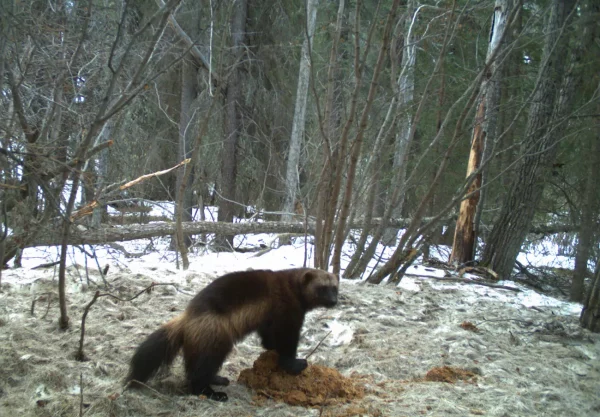
After more than two decades of petitions by wildlife conservation groups, the U.S. Fish and Wildlife Service has listed wolverines as a threatened species under the Endangered Species Act.
The decision marks a win for conservation groups, who have petitioned for a federal listing since 1995 and have gone through six rounds of successful litigation to secure federal protections. Washington is one of the few states where the animals still live, with populations throughout the Cascade range, according to the Washington Department of Fish and Wildlife.
According to the Endangered Species Act, a “threatened species” is a species likely to become an endangered species within the foreseeable future throughout all or a significant portion of its range. Whereas, an “endangered species” is a species in danger of extinction throughout all or a significant portion of its range.
Under the new protections, the U.S. Fish and Wildlife Service must prepare a wolverine recovery plan, identify protected critical habitat in the future, and possibly plan for reintroduction of the species into Colorado.
“Biologists estimate a loss of more than 40% of suitable wolverine habitat in Idaho by 2060 if we fail to act,” Jeff Abrams, wildlife program associate for the Idaho Conservation League, said in a press release Wednesday. “This decision allows us to move forward on recovery actions to prevent such extensive loss of wolverine habitat and recover wolverine populations.”
Decision comes after decades of petitions, lawsuits
Wolverines were first petitioned to be listed under the Endangered Species Act in 1995, but the U.S. Fish and Wildlife Service determined that the petition and the information within its records lacked evidence to suggest that listing the wolverine as threatened or endangered in the Lower 48 might be justified.
Then in 2014, Fish and Wildlife issued and then withdrew a proposal to list wolverines.
Western conservation groups then sued the U.S. Fish and Wildlife Service in the District Court for the District of Montana challenging the agency’s decision to withdraw the proposal. In 2020, the groups went to court to compel the federal agency to complete a final Endangered Species Act listing determination on wolverines in the Lower 48.
As reported by WyoFile, Fish and Wildlife published a 100-page “species status assessment” on North American wolverines in September, which previewed the decision that federal wildlife managers had to make by the end of November — the deadline specified in the federal court order.
Wolverines in the Lower 48
Wolverines are medium-sized, solitary carnivores that live in high-elevation habitats. Males can weigh up to 40 to 50 pounds. The species relies on deep snowpack for rearing their young, and they are adapted for digging, climbing and traveling long distances during the winter.
Wolverine populations are naturally small in high-elevation alpine habitats. However, Fish and Wildlife predicts that human disturbance and the main threat of climate change affecting spring snow will further shrink and fragment their habitats.
“The science is clear: snowpack-dependent species like the wolverine are facing an increasingly uncertain future under a warming climate,” Michael Saul, program director for Defenders of Wildlife Rockies and Plains, said in the press release. “The protections that come with Endangered Species Act listing increase the chance that our children will continue to share the mountains with these elusive and fascinating carnivores.”
Wolverines were once found across the northern tier of the U.S, stretching from states like Montana and Idaho to regions as far south as New Mexico in the Rockies and Southern California in the Sierra Nevada range.
But after more than a century of unregulated trapping and habitat degradation, wolverines in the Lower 48 only exist in small populations in Idaho, Montana, Washington, Wyoming and northeast Oregon.
The animals were not known to be living in Washington by the mid-1900s but became re-established in the North Cascades during the 1990s and in the Cascades south of Interstate 90 by 2008, according to the Washington Department of Fish and Wildlife.
There is limited population data on wolverines, but in 2014, Fish and Wildlife estimated a population between 250 to 300 in the Lower 48. While the latest species status assessment does not include an updated population estimate, research indicates the species are widely spread and move across state borders.
Washington’s Department of Fish and Wildlife estimates that the wolverine population in the Cascades is probably less than 25, but appears to be relatively stable. Still, the agency says that declining snowpack and other climate-related threats could cause problems for the animals in the coming years.
Conservationists from across the West expressed gratitude at the decision to list wolverines under the Endangered Species Act, including Andrea Zaccardi, the Center for Biological Diversity’s carnivore conservation legal director.
“I’m thrilled that the Fish and Wildlife Service finally followed the science and granted wolverines the federal protections they need to survive and recover,” she said in the press release. “Like so many other species, wolverines waited far too long for federal protections, but I’m overjoyed that they’re finally on the path to recovery.”
— By Mia Maldonado, Washington State Standard
Washington State Standard is part of States Newsroom, a nonprofit news network supported by grants and a coalition of donors as a 501c(3) public charity. Washington State Standard maintains editorial independence. Contact Editor Bill Lucia for questions: [email protected]. Follow Washington State Standard on Facebook and Twitter.
